|
||||
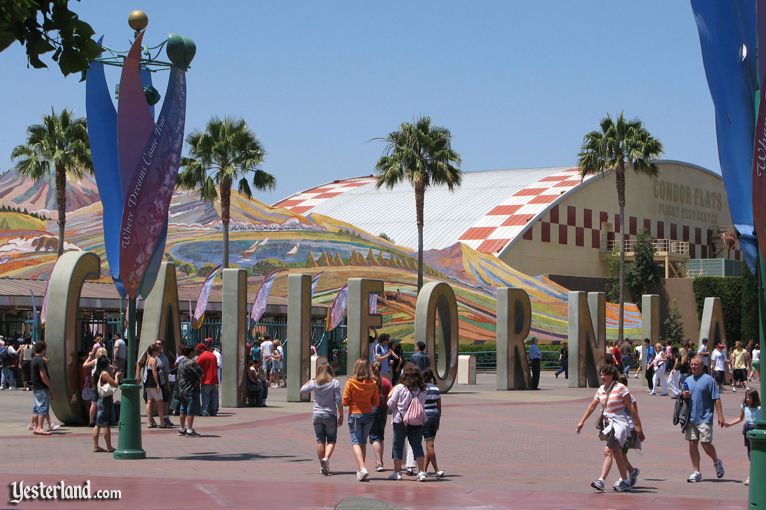
Photo by Werner Weiss, 2007 Approaching the park entrance |
||||
|
|
||||
|
Yester California Adventure is the only theme park that you enter by walking into a postcard — a huge postcard. And that doesn’t mean a big, flat mega-billboard that looks like a postcard. It means a three-dimensional space that looks like a giant postcard from a distance. Well, not really. When you’re actually there, it doesn’t look much like a postcard. It looks like a large, three-dimensional space with big letters spelling California. Chances are you’re approaching it from one side or the other, because that’s where the parking lot trams are. So the postcard elements don’t line up. And you’re focused on getting to the turnstiles so that you can enter the park. |
||||
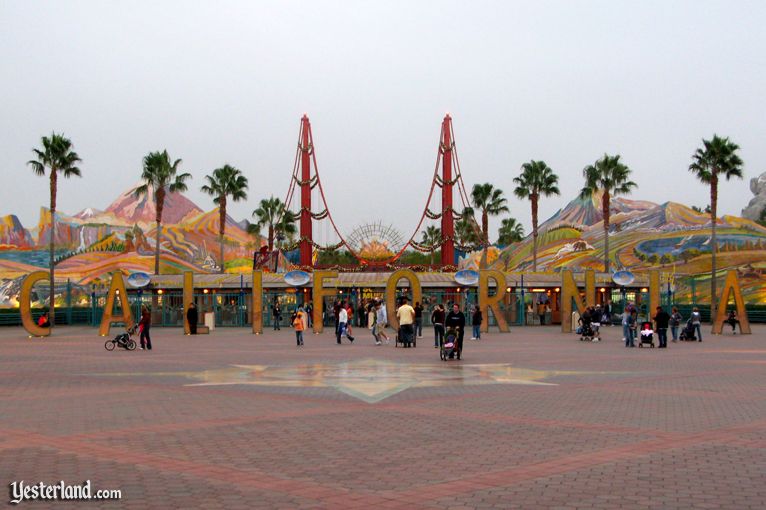
Photo by Werner Weiss, 2007 A California postcard! |
||||
|
But if you know it’s supposed to look like a postcard, and you stand in the right place, and you frame a shot with your camera just right, you can wind up with a photo that looks somewhat like a classic California picture postcard! Cool, eh? |
||||
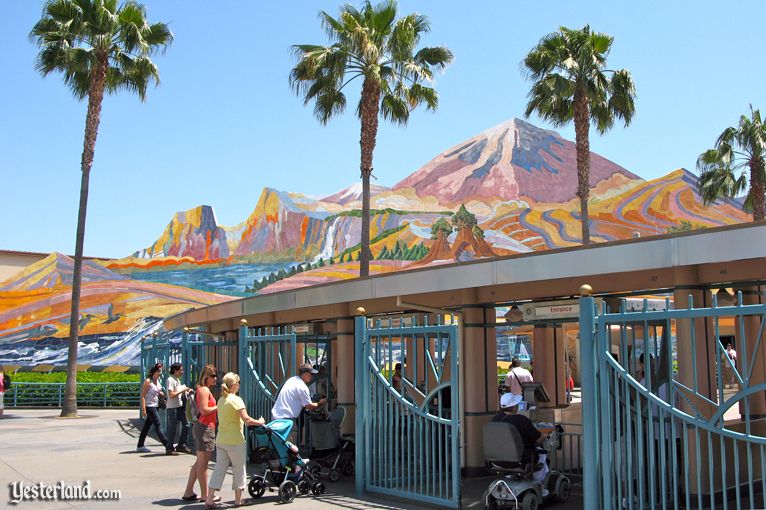
Photo by Werner Weiss, 2010 Main Gate |
||||
|
Don’t be in too much of a hurry to get though a turnstile so you can rush off to Superstar Limo or the Orange Stinger. The colorful art “mountains” on either side of the main gate aren’t painted. They are magnificent ceramic murals. In fact, you’re between the two halves of the California Mural, the largest ceramic mural in the world. |
||||
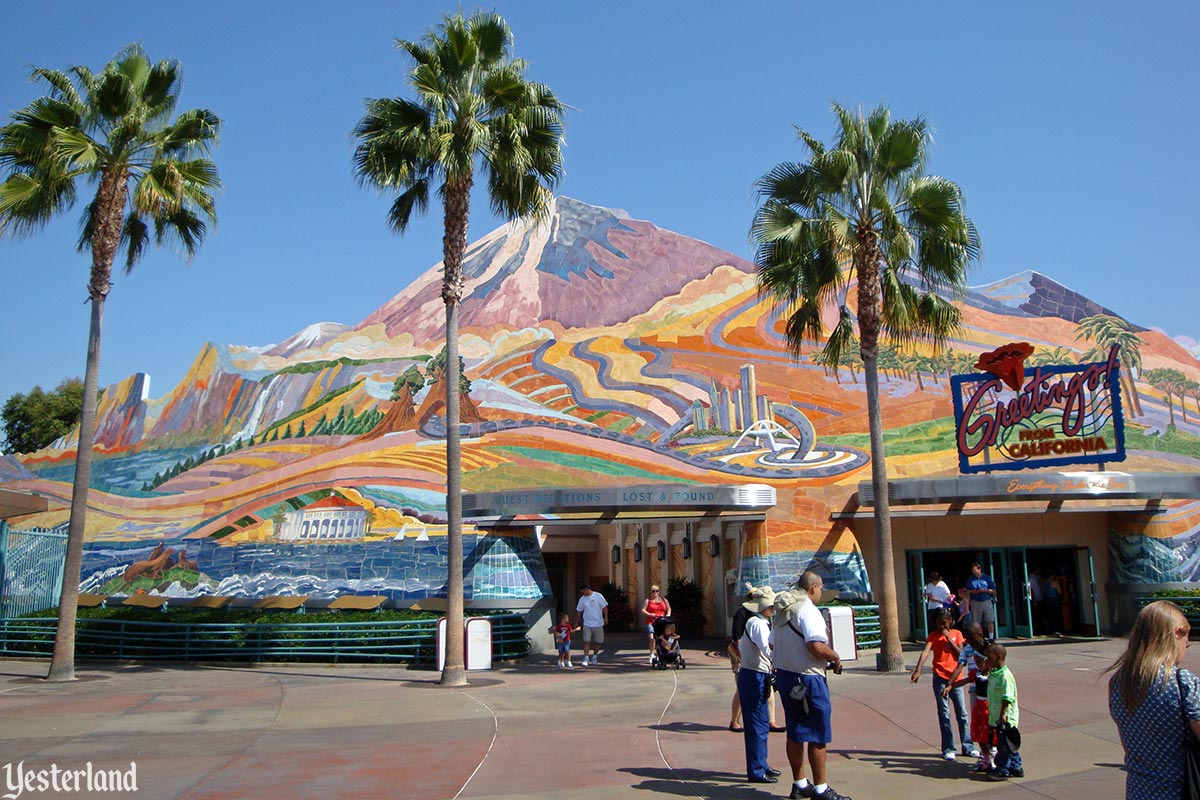
Photo by Chris Bales, 2008 A mountain-shaped mural, with mountains on it |
||||
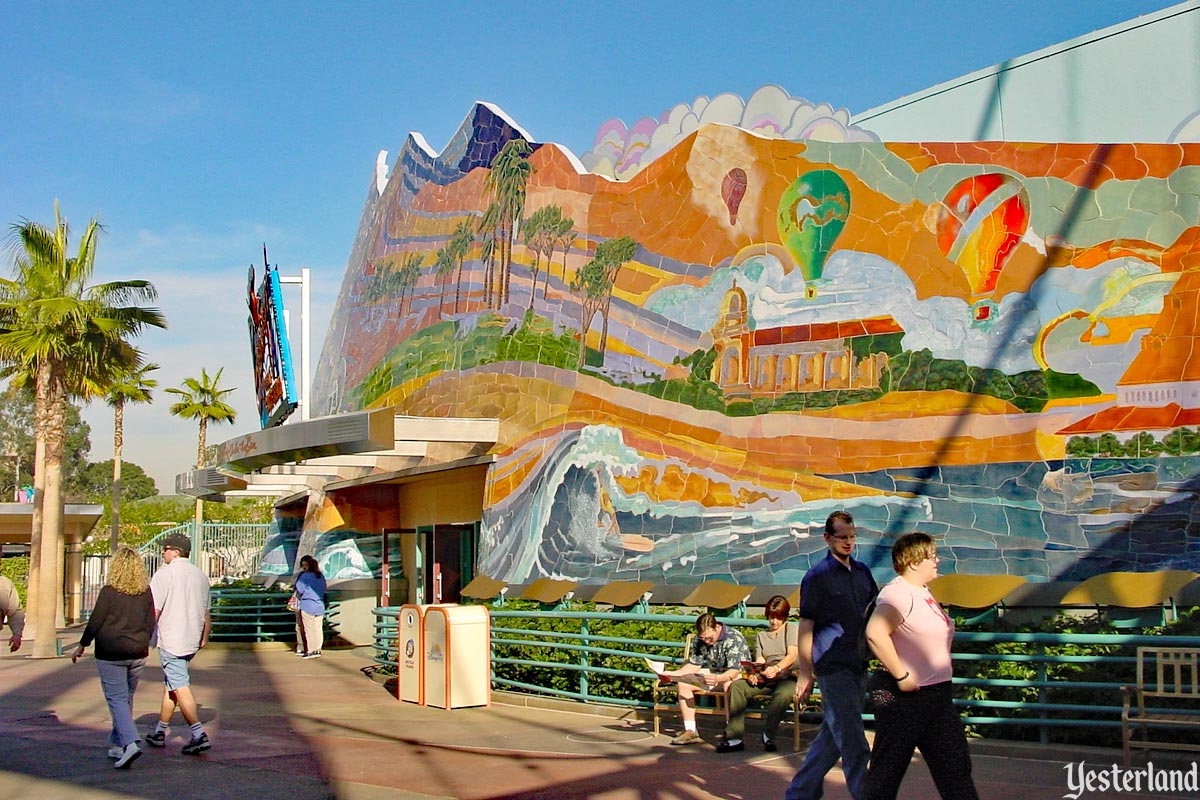
Photo by Allen Huffman, 2002 Greetings from California, the park’s biggest souvenir store |
||||
|
Openings at the base of both halves of the mural provide entrances to restrooms, guest services, and Greetings from California, this park’s answer to the Disneyland Emporium. Ceramic is a very durable material, and the colors don’t fade the way paint does. This mural should last for generations! Take some time to admire the details. It’s quite a nice work of art. |
||||
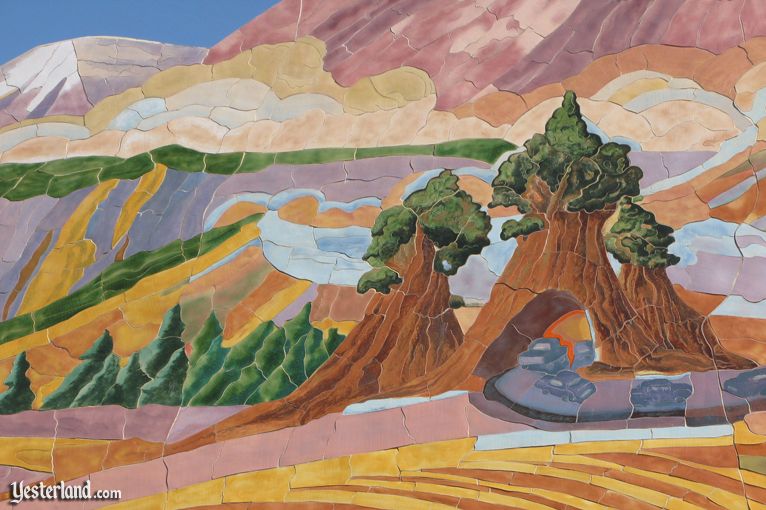
Photo by Werner Weiss, 2009 Wawona Tree, Yosemite |
||||
|
There really was a tree you could drive through at Yosemite National Park. It was the Wawona Tree at Mariposa Grove. The mighty sequoia was over 2,000 years old in 1881 when a 7-foot-wide tunnel was built through it as a tourist attraction. That was nine years before Yosemite became a National Park. Somehow, the Wawona Tree lived for another 88 years before it toppled over in 1969. One reason for its demise was a severe winter. The other reason was that a normal, healthy sequoia doesn’t have an automobile tunnel through its trunk. |
||||
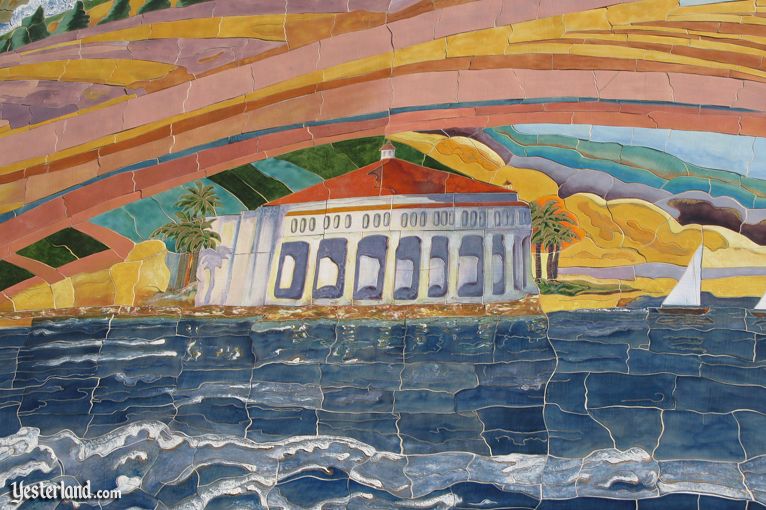
Photo by Werner Weiss, 2009 Catalina Casino in Avalon, Catalina Island |
||||
|
Now sing along...
Twenty-six miles across the sea The landmark Catalina Casino opened in 1929 at Avalon Harbor on Catalina Island. In this case, casino does not mean a gambling hall. It’s a word that Italians use for a social gathering place. In fact, casino comes from the diminutive form of casa (house). But the Catalina Casino is anything but diminutive. It’s 140 feet tall — just 7 feet shorter than Disneyland’s Matterhorn Mountain — and contains a magnificent single-screen movie theater with 1,184 seats and a huge circular ballroom above it. |
||||
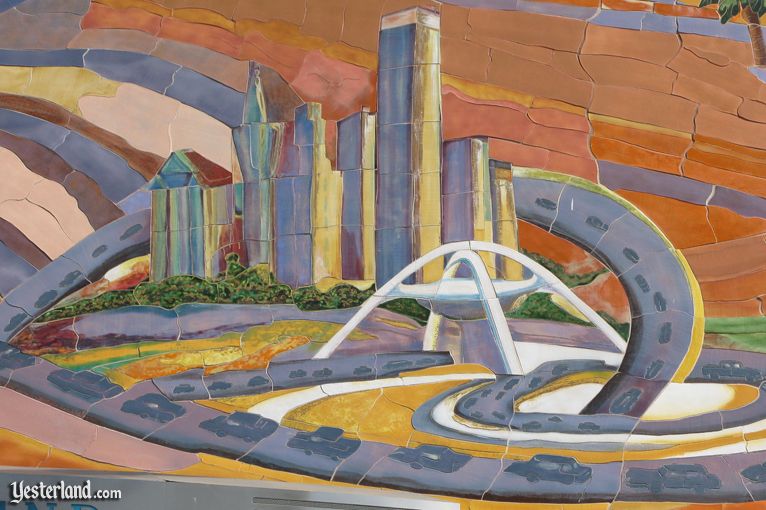
Photo by Werner Weiss, 2009 Los Angeles |
||||
|
Los Angeles is represented by its soaring downtown skyline, the iconic Theme Building at Los Angeles International Airport, and the ubiquitous freeways. The futuristic Theme Building, designed by the architectural firm of Pereira & Luckman, opened in 1961 as the centerpiece of the airport’s new terminal complex. There’s even a Disney connection. In 1997, after a $4 million interior update designed by Walt Disney Imagineering, the retro-futuristic Encounter Restaurant replaced the tired Theme Restaurant in the “space age” landmark. Sadly, Encounter closed permanently at the end of 2013. |
||||
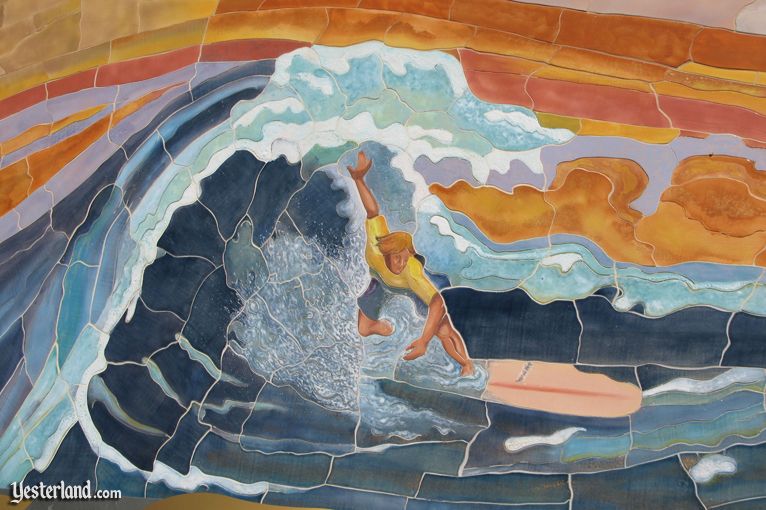
Photo by Werner Weiss, 2009 Surfer |
||||
|
Surfing may have started as the sport of Hawaiian kings, but historians of surfing (yes, there are such historians) report that the history of surfing in California goes back to 1885. That’s when three Hawaiian princes brought the sport to Santa Cruz, California, during their summer break from their school, St. Matthew’s Hall in San Mateo. Legendary Hawaiian surfer Duke Kahanamoku surfed San Diego’s Ocean Beach in 1916. But surfing in California really caught on in the 1950s — around the time that Disneyland opened — and its popularity has been increasing ever since then. California even has four museums devoted to surfing. |
||||
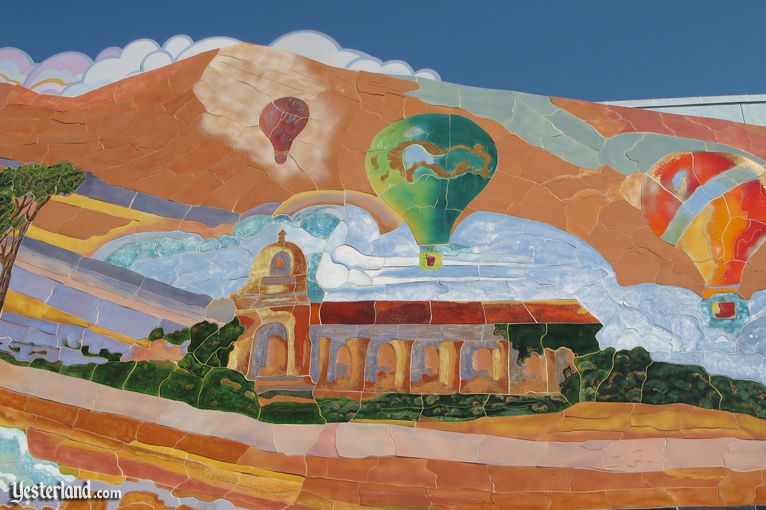
Photo by Werner Weiss, 2009 California Mission and a Balloon Festival |
||||
|
Every California schoolchild learns about Father Junipero Serra (1713-1784), who founded California’s first nine Spanish missions beginning in 1769. By 1823, there were 21 missions, stretching from San Diego to Sonoma. California has several hot air balloon festivals each year, such as the Temecula Valley Balloon and Wine Festival. |
||||
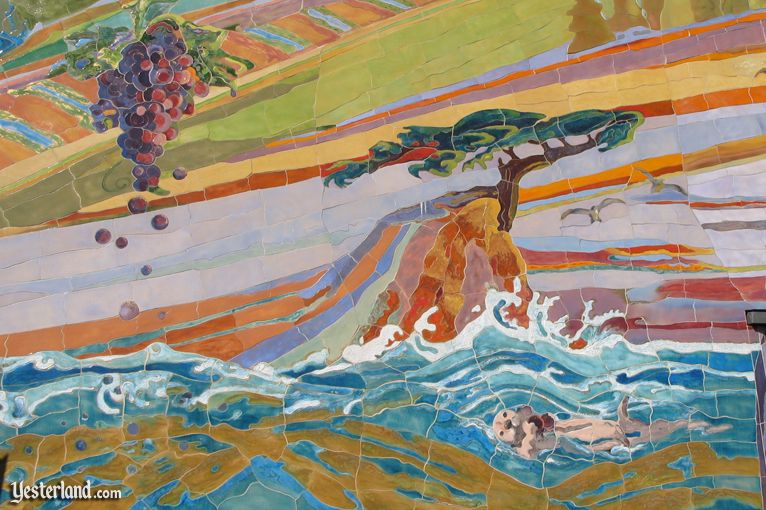
Photo by Werner Weiss, 2010 The Lone Cypress Tree and a Sea Otter |
||||
|
The Lone Cypress Tree is not just the logo of the Pebble Beach Golf Links. It’s an actual tree, dramatically perched on a rocky cliff jutting into the Pacific Ocean. You can see this landmark tree along the scenic 17 Mile Drive between Carmel and Pacific Grove. Sea otters really do live in the waters below the tree, although it’s hard to see them from the shore. To see them, head to the nearby Monterey Bay Aquarium instead. |
||||
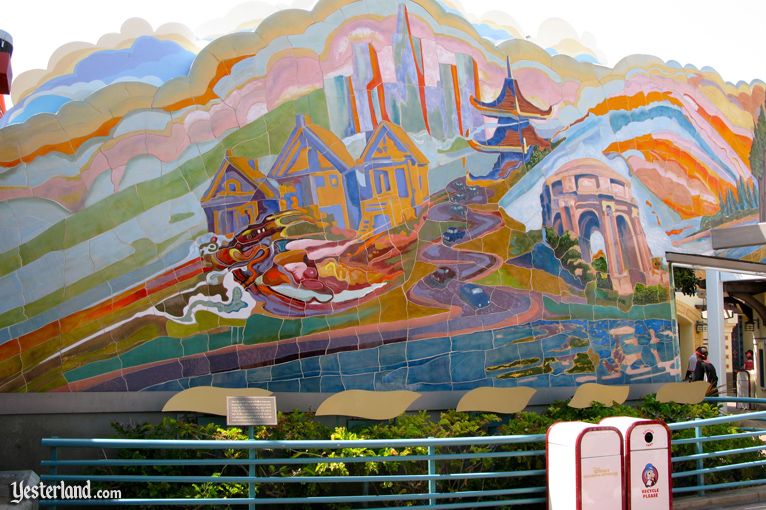
Photo by Werner Weiss, 2010 San Francisco |
||||
|
San Francisco is one of the most beautiful cities in the world, even if this isn’t the most beautiful part of the ceramic mural. The landmarks represented here include the skyline, Victorian homes, Chinatown, Lombard Street, the Palace of Fine Arts, and something else. The “something else” might be a dragon. Or it might be a pile of food. Or perhaps — although this makes no sense — it could be animal innards. |
||||
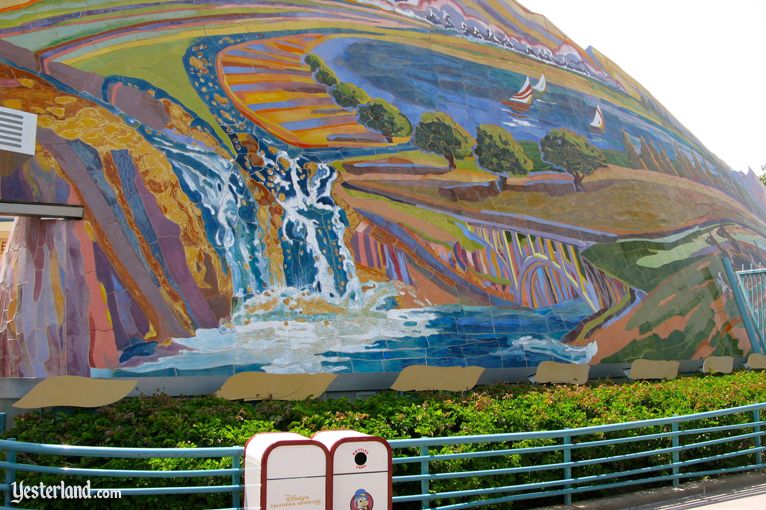
Photo by Werner Weiss, 2010 California State Route 1 |
||||
|
One of the most dramatic parts of California State Route 1, the road along California’s coastline, is the Bixby Creek Bridge in Big Sur. Completed in 1932, the reinforced concrete arch bridge offers great views of the rugged coast. The real Bixby Creek Bridge does not cross a deep blue bay, and is not flanked by massive waterfalls. |
||||
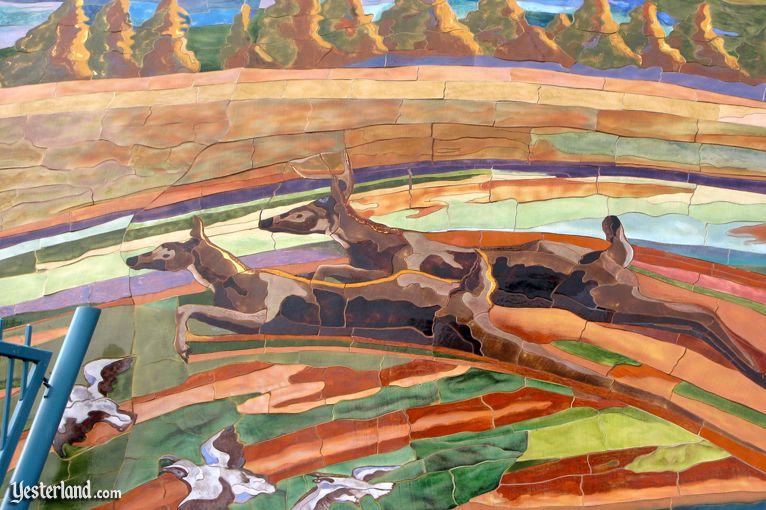
Photo by Werner Weiss, 2007 Deer jumping across the entrance barrier |
||||
|
Stop those deer! They’re jumping across the barrier into the park without a ticket. California has a lot of people, but it also has a lot of wildlife. |
||||
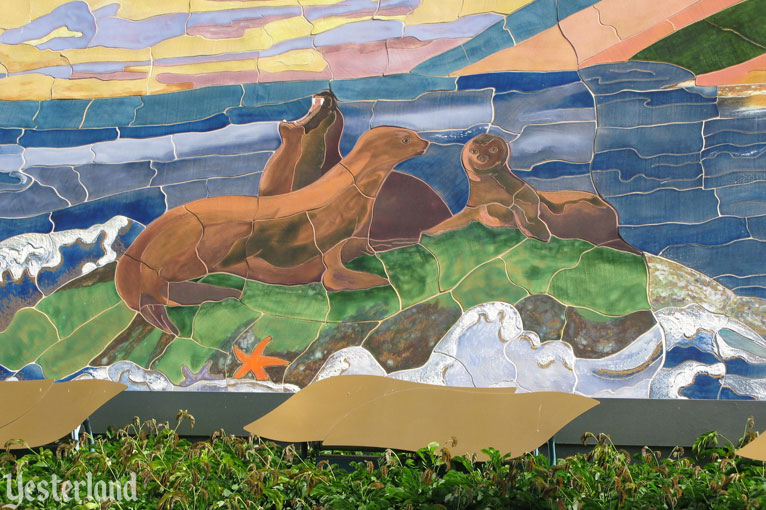
Photo by Werner Weiss, 2009 Sea Lions |
||||
|
Speaking of wildlife, it’s only fitting to include a species that has the state as part of its name. It’s the California Sea Lion (Zalophus californianus). |
||||
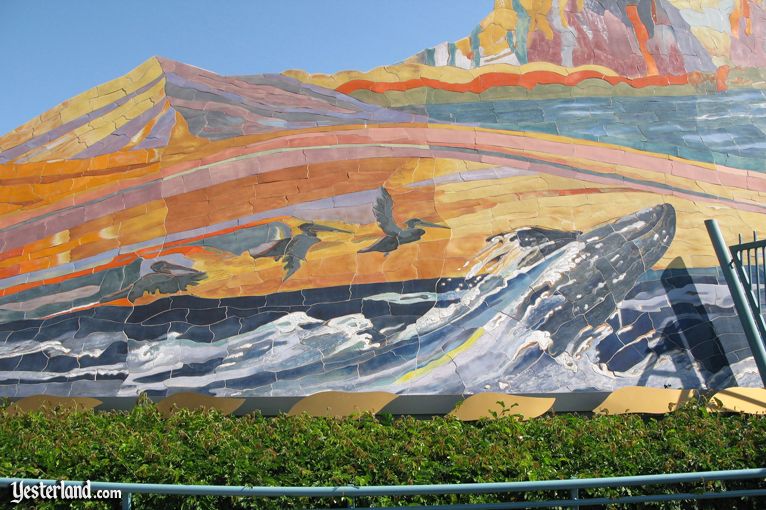
Photo by Werner Weiss, 2009 Pelicans and Whales |
||||
|
Now sing along...
California, here I come |
||||
|
|
||||
|
The picture postcard entrance, with the “the Largest Ceramic Mural in the World,” was part of Disney’s California Adventure when the park opened in February 2001. The Imagineers who designed the entrance wanted to do something dramatic and different. At the time that Disney’s California Adventure was being designed, Tim Delaney had the role of Creative Director, Producer & Field Art Director of the Entrance Complex & Paradise Pier. Tim Delaney now has his own design firm, Tim J Delaney Design Inc. His firm’s website used to proudly describe the entrance design: “Tim created the design and lead the team of the main entrance complex for Disney’s California Adventure to read like a picture postcard from ‘Sunny California.’ Welcoming you are giant letters lined in glittering gold mirrors spelling out CALIFORNIA. He included rich icons from the Golden State such as the Golden Gate Bridge — with a monorail gliding across it, the Sun Icon and Wave Fountain, and twin ceramic tile murals representing imagery from Northern and Southern California.” Husband-and-wife artists Dimitri Lazaroff and Theodora Kurkchiev of TND Studio, Inc. in San Pedro created the spectacular ceramic mural. They’re the same artists who created the fountain at the Aquarium of the Pacific in Long Beach and the largest 3D mosaic in the world — the entrance to Mermaid Lagoon at Tokyo Disney Sea. In a Los Angeles Times article (“California, the Mural,” Feb. 4, 2001), reporter David Lansing quoted artist Theodora Kurkchiev: “We started work in February of 2000. Dimitri told them it would take at least 19 months to do this, but Disney wanted it in half that time. I should say that we performed a miracle. I worked seven days a week, 12 to 16 hours a day, hand-painting each and every tile. I couldn’t take even one day off in the last six months because I was afraid we would not make it. Tomorrow we fire the last batch of tiles, and the next day I go to my doctor because my back is so bad.” It must have seemed like a good idea to do something original and artistic to welcome guests into the California-themed park. Unfortunately, the result came across as rather cold. Even though the mural was probably very costly, it came across as cheap-looking — mere decorations on walls. |
||||
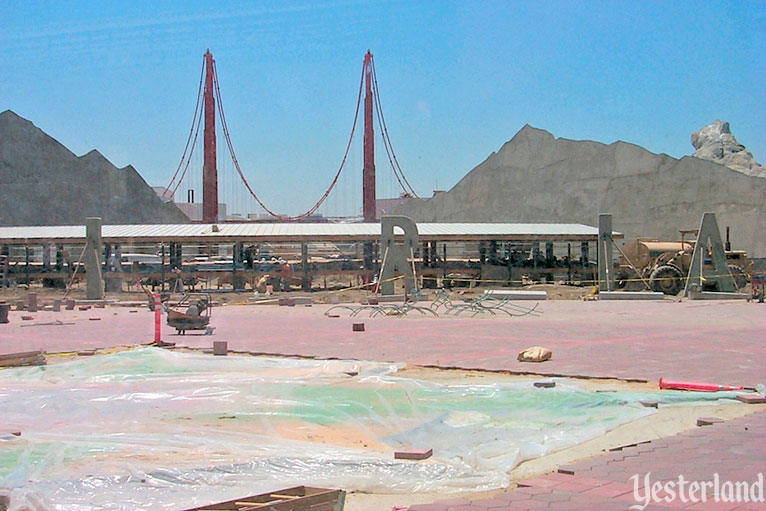
Photo by Tony “WisebearAZ” Moore, 2000 Blank concrete walls during park construction |
||||
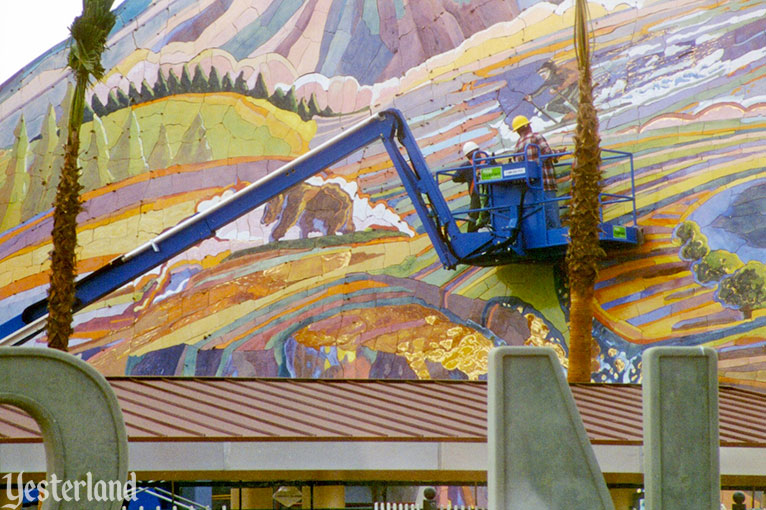
Photo by Tony “WisebearAZ” Moore, 2000 Completing a section of the mural |
||||
|
The ceramic mural was a great work of monumental art by talented artists — but it was in the wrong place. If it had adorned a prominent spot at an airport or convention center, it might have become a beloved and respected landmark. Not far away from the entrance to Disney’s California Adventure, the entrance to Disneyland Park provides a warm, welcoming experience. Tunnels on either side of an old-fashioned railroad station take guests back in time to a town square at the turn of the 20th century. Some of the original designers of Disneyland, including Harper Goff and Marvin Davis, came from the world of motion picture art direction. Their studio jobs had been to create believable, detailed exteriors and interiors for movies that would transport viewers to other places and times. Others, including Ken Anderson and Herb Ryman, came from animation, where, beginning with blank sheets of paper, artists bring entire worlds to life. These designers used their skills to create immersive environments for Disneyland guests. Somehow, they and their boss, Walt Disney, knew instinctively that it wouldn’t be enough just to apply decorations to walls. |
||||
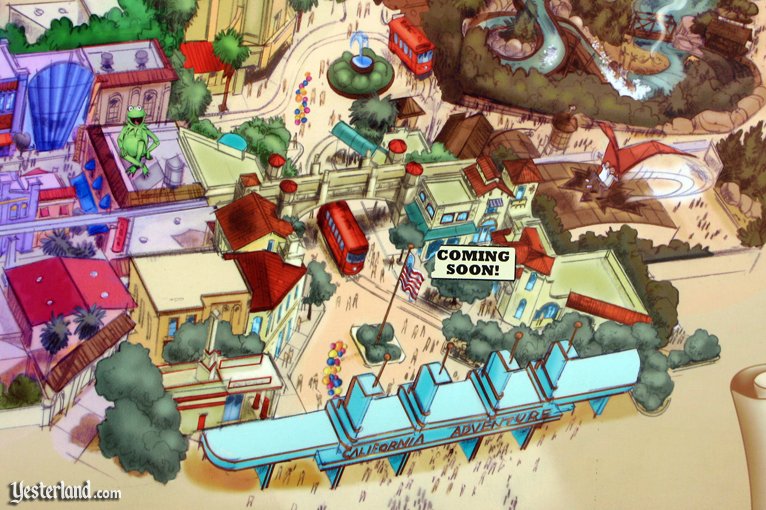
Photo by Werner Weiss, 2010 Excerpt from a map of Disney’s California Adventure (© Disney) |
||||
|
When plans for the $1.1 billion redo of Disney’s California Adventure were announced in late 2007, artwork and a model showed that the entrance complex, including the ceramic murals, would be replaced by a streetscape representing Los Angeles when a young Walt Disney arrived from Kansas City with dreams and little else. A montage on the exterior of Blue Sky Cellar, the park’s preview gallery, described Buena Vista Street: The new entrance to the Park, this is 1920s Los Angeles as Walt Disney experienced it… the charming and enterprising merchants, the tantalizing restaurants, the grand Carthay Circle Theatre, and the jaunty Red Car Trolley to take you where you want to go. Buena Vista Street is a reflection of the energy, optimism, personality and stories of the hundreds of thousands of immigrants from across the country and around the world who came to California with just pennies in their pocket, but a wealth of dreams. After the end of the busy summer 2010 season, serious work began on the entrance complex. On Internet message boards, fans hoped that giant mural would be relocated. But that really wasn’t an option. The mural, with large pieces of fragile ceramic cemented permanently to concrete walls, was designed to last for a long time — but not to be dismantled and moved. In October 2010, demolition of the ceramic murals began. It must have been painful for Kurkchiev and Lazaroff to see their art destroyed. If the California Mural had remained in place, it would no longer be the world’s largest ceramic mural. That honor now belongs to the Hanoi Ceramic Mosaic Mural in Hanoi, Vietnam. Work on it began in 2007 and finished in 2010. It’s a staggering 12,631 feet long! |
||||
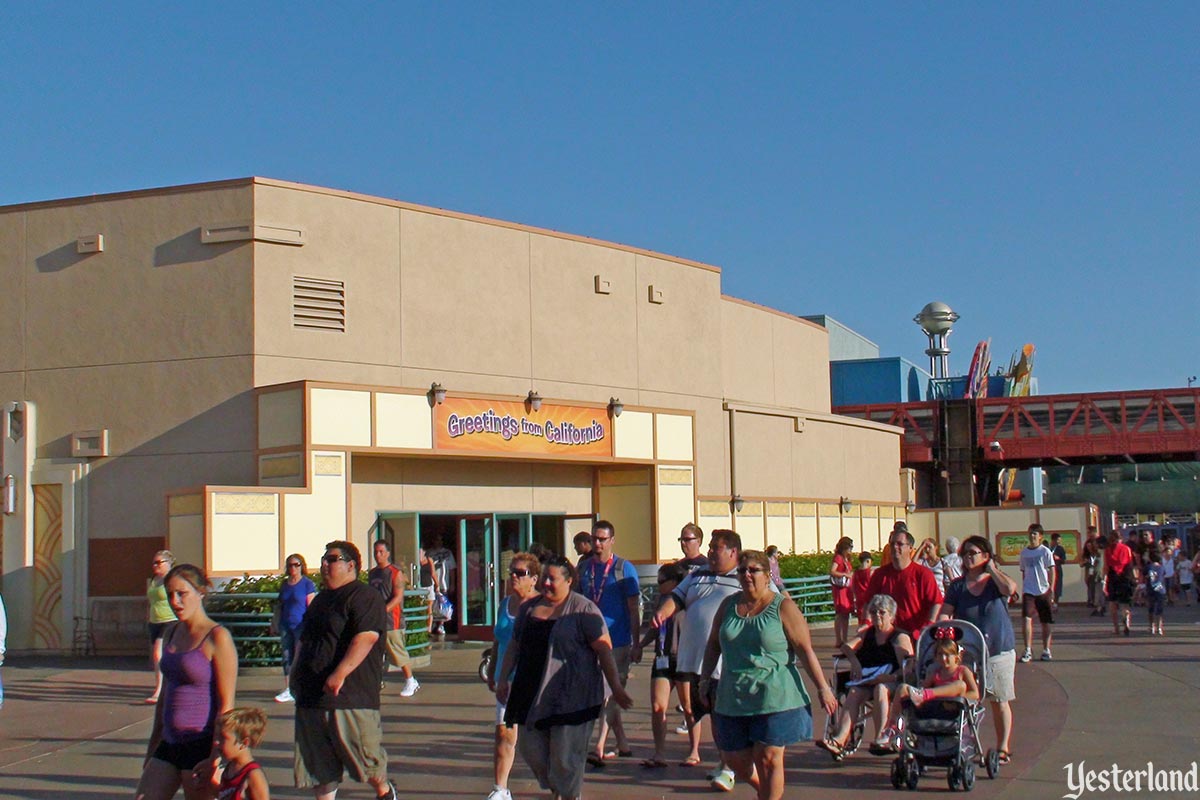
Photo by Chris Bales, 2011 After the mural was demolished, but before the transition to Buena Vista Street |
||||
|
When Buena Vista Street opened June 15, 2012, park guests were delighted. Where the ceramic mural had once covered both sides of the entrance lane, charming façades evoked Los Angeles in 1923. Behind those façades, the shop interiors continued the theme. |
||||
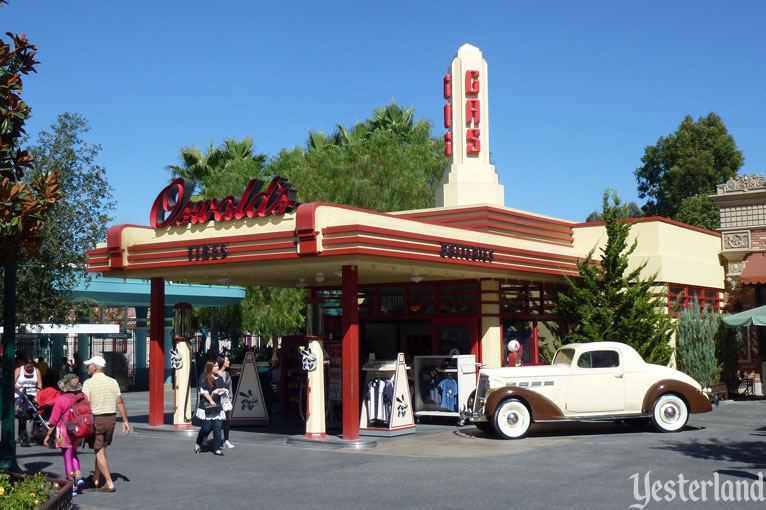
Photo by Werner Weiss, 2014 Oswald’s on Buena Vista Street |
||||
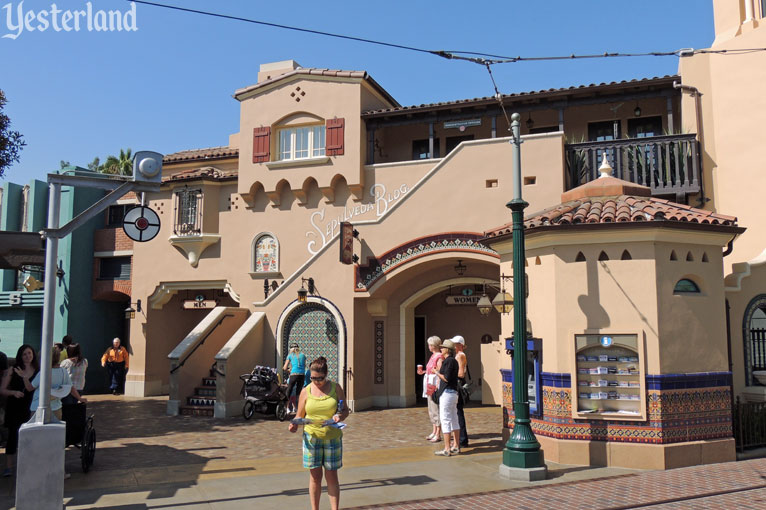
Photo by Werner Weiss, 2013 Buena Vista Street façade for the restrooms |
||||
|
But one piece of DCA 1.0 survived — and it also involved ceramic tiles. The men’s and women’s restrooms in the Sepulveda building are the original restrooms from 2001 — with their original decorative tiles. |
||||
|
|
Click here to post comments at MiceChat about this article.
© 2025 Werner Weiss — Disclaimers, Copyright, and Trademarks Updated January 10, 2025 |
|||
